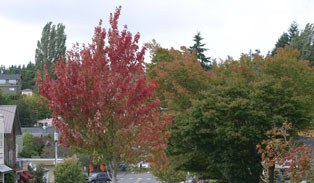Landscaping can say many different things about a city. In Langley’s case, a tiny community with streets adorned by hundreds of trees, officials say a little definition is needed.
The city’s citizen Planning Advisory Board is looking at a best practices guide, which would identify plants and designs that may best work in the Village by the Sea.
“We’re still really early in that particular goal,” said Thomas Gill, the board’s chairman and an unopposed Langley City Council candidate. “We’re still brainstorming what we’re trying to do with it.”
The best practices guide, as Gill called it, will likely include ways to limit water usage and runoff from yards. He said the planning board may recommend a list of drought-resistant plants, many of which will be native to the area.
“We don’t want to add any burdens to business owners or residents,” he said. “We’re just trying to guide people to things that won’t impact right of ways for pedestrians or utilities.”
Planning Director Jeff Arango said city code states, “All lots shall be generously landscaped.” The planning board will try to add detail to the landscaping rules, giving residents more direction for their yards and lawns, he said.
The planning board will meet at 3 p.m. at City Hall on Wednesday, Oct. 9.
Also on the board’s agenda is to look at tree standards. That task, Gill said, is less clear and board members are divided. Other than recommending residents not use noxious plants such as bamboo, the planning board has yet to reach consensus on several issues.
“Everything beyond that, we’re kind of running into a brick wall,” Gill said.
For Langley residents looking to chop down a tree, the planning board asks them to check with city staff first to protect historic trees when possible. One of the only agreed-upon ordinances for tree protection is one created years ago in response to the construction of the South Whidbey Fire/EMS station on Camano Avenue.
In 2012, Arango began an inventory of trees planted in rights of way, though that was later put on hold. The rules and guides would define what the city is allowed to do — such as maintain utility lines, which can tangle with tree branches, and establish residents’ duties. A heritage tree could be cut down now at a single-family residence if the tree was damaging infrastructure and blocking sunlight access for gardens or solar panels.
“We may consider some further requirements for trees and tree clearing,” Arango said. “One of the things we have to consider is our ability to enforce it.”



